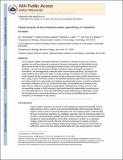Determinants of Homodimerization Specificity in Histidine Kinases
Author(s)
Ashenberg, Orr; Rozen-Gagnon, Kathryn; Keating, Amy E.; Laub, Michael T
DownloadKeating_Determinants of.pdf (1.247Mb)
PUBLISHER_CC
Publisher with Creative Commons License
Creative Commons Attribution
Terms of use
Metadata
Show full item recordAbstract
Two-component signal transduction pathways consisting of a histidine kinase and a response regulator are used by prokaryotes to respond to diverse environmental and intracellular stimuli. Most species encode numerous paralogous histidine kinases that exhibit significant structural similarity. Yet in almost all known examples, histidine kinases are thought to function as homodimers. We investigated the molecular basis of dimerization specificity, focusing on the model histidine kinase EnvZ and RstB, its closest paralog in Escherichia coli. Direct binding studies showed that the cytoplasmic domains of these proteins each form specific homodimers in vitro. Using a series of chimeric proteins, we identified specificity determinants at the base of the four-helix bundle in the dimerization and histidine phosphotransfer domain. Guided by molecular coevolution predictions and EnvZ structural information, we identified sets of residues in this region that are sufficient to establish homospecificity. Mutating these residues in EnvZ to the corresponding residues in RstB produced a functional kinase that preferentially homodimerized over interacting with EnvZ. EnvZ and RstB likely diverged following gene duplication to yield two homodimers that cannot heterodimerize, and the mutants we identified represent possible evolutionary intermediates in this process.
Date issued
2011-08Department
Massachusetts Institute of Technology. Computational and Systems Biology Program; Massachusetts Institute of Technology. Department of BiologyJournal
Journal of Molecular Biology
Publisher
Elsevier
Citation
Ashenberg, Orr, Kathryn Rozen-Gagnon, Michael T. Laub, and Amy E. Keating. “Determinants of Homodimerization Specificity in Histidine Kinases.” Journal of Molecular Biology 413, no. 1 (October 2011): 222–235.
Version: Author's final manuscript
ISSN
00222836
1089-8638